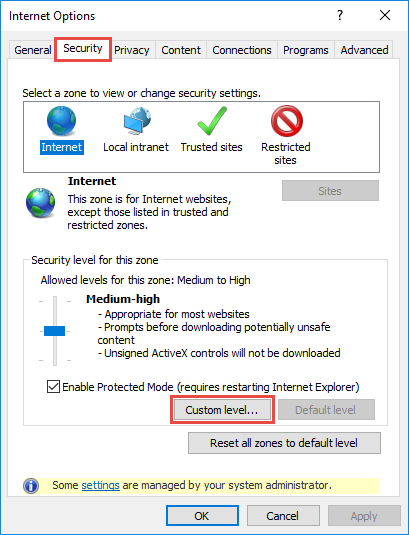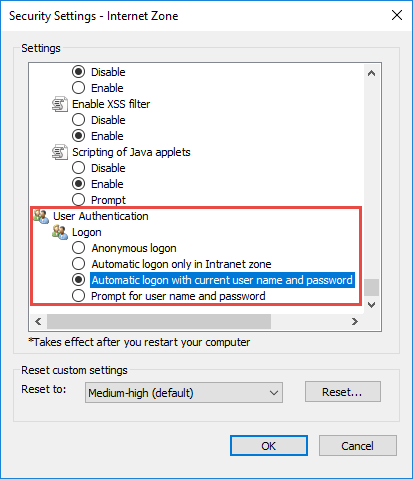Set up LDAP authentication
Set up user authentication through LDAP on .NET Framework
To enable user authentication through LDAP, modify the Web.config file in the Creatio root folder. Active Directory and OpenLDAP settings are different.
Specify "Ldap" and "SspLdapProvider" in the list of available authentication providers. The step is the same for Active Directory and OpenLDAP.
<terrasoft>
<auth providerNames="InternalUserPassword,Ldap,SSPLdapProvider" autoLoginProviderNames="" defLanguage
="en-US" defWorkspaceName="Default" useIPRestriction="false" loginTimeout="30000">
<providers>
Upper/lowercase characters must be as in the example. Also, note that the provider names must be separated by commas with no blank spaces.
Specify the server IP or URL, as well as user domain parameters in the "Ldap" section. Active Directory and OpenLDAP parameters are different.
- For Active Directory
- For OpenLDAP
<provider name="Ldap" type="Terrasoft.WebApp.Loader.Authentication.Ldap.LdapProvider, Terrasoft.WebApp.Loader">
<parameters>
...
<add name="ServerPath" value="testactivedirectory.com" />
<add name="AuthType" value="Ntlm" />
<add name="DistinguishedName" value="dc=tscrm,dc=com" />
<add name="UseLoginUserLDAPEntryDN" value="false" />
<!--<add name="SearchPattern"
value="(&(objectCategory=person)(objectClass=user)
(!(userAccountControl:1.2.840.113556.1.4.803:=2))
memberOf=CN=SVNUsers,OU=groups,OU=Terrasoft,DC=tscrm,DC=com))" />-->
<add name="SearchPattern"
value="(&(sAMAccountName={0})(objectClass=person))" />
<!--With Kerberos authentication-->
<add name="KeyDistributionCenter" value="ctl.com" />
</parameters>
<provider name="Ldap" type="Terrasoft.WebApp.Loader.Authentication.Ldap.LdapProvider, Terrasoft.WebApp.Loader">
<parameters>
...
<add name="ServerPath
" value="testopenldap.com" />
<add name="AuthType" value="Basic" />
<add name="DistinguishedName" value="dc=example,dc=org" />
<add name="UseLoginUserLDAPEntryDN" value="true" />
<add name="SearchPattern"
value="(&(uid={0})(objectClass=inetOrgPerson))" />
<!--With Kerberos authentication-->
<add name="KeyDistributionCenter" value="ctl.com" />
</parameters>
If you select "Kerberos" authentication type, make sure your Creatio application server is joined to the same domain as the LDAP server and the key distribution center.
Specify the server IP or URL, as well as portal user domain parameters in the "SspLdapProvider" section. The step is the same for Active Directory and OpenLDAP:
<provider name="SSPLdapProvider" type="Terrasoft.WebApp.Loader.Authentication.SSPUserPassword.SSPLdapProvider, Terrasoft.WebApp.Loader">
<parameters>
...
<add name="ServerPath" value="ldapserver.domain.com" />
...
<add name="DistinguishedName" value="dc=domain, dc=com" />
...
</parameters>
Save the changes in the Web.config file.
Additional step for OpenLDAP : before you synchronize with the OpenLDAP server, specify the "true" value for "UseLoginUserLDAPEntryDN" in the Web.config file of Terrasoft.WebApp.
<appSettings>
...
<add key="UseLoginUserLDAPEntryDN" value="true" />
This setting ensures that Creatio does not us an empty LDAPEntryDN field in the SysAdminUnit table to synchronize the users. An empty LDAPEntryDN field is known to cause authentication issues.
Set up user authentication through LDAP on .NET Core or .NET 6
To enable user authentication through LDAP, modify the Terrasoft.WebHost.dll.config file in the Creatio root folder. Active Directory and OpenLDAP settings are the same.
Specify "Ldap" in the list of available authentication providers. Add the "SspLdapProvider" provider to allow portal users to log in to Creatio:
<terrasoft>
<auth providerNames="InternalUserPassword,Ldap,SspLdapProvider" autoLoginProviderNames="" defLanguage="en-US" defWorkspaceName="Default" useIPRestriction="false" loginTimeout="30000">
<providers>
Upper/lowercase characters must be as in the example. Also note that the provider names must be separated by commas with no blank spaces.
Specify the "Ldap" authentication provider settings:
<provider name="LdapProvider" type="Terrasoft.Authentication.Core.Ldap.NetStandardLdapProvider, Terrasoft.Authentication">
<parameters>
<add name="ServerPath" value="testldap.com" />
<add name="DistinguishedName" value="dc=ctl,dc=com" />
<add name="UseLoginUserLDAPEntryDN" value="false" />
<add name="SearchPattern" value="(&(sAMAccountName={0})(objectClass=person))" />
<!--With Kerberos authentication-->
<add name="KeyDistributionCenter" value="ctl.com" />
<!--When using LDAPS-->
<add name="SecureSocketLayer" value="false" />
<add name="CertificateFileName" value="" />
</parameters>
</provider>
If you select "Kerberos" authentication type, make sure your Creatio application server is joined to the same domain as the LDAP server and the key distribution center.
To use the secure LDAPS protocol , specify the following parameters in the authentication provider settings:
SecureSocketLayer is the flag that enables LDAPS.
CertificateFileName is the name of the SSL certificate that validates the LDAPS connection. The certificate must be located in the Creatio root folder. This is a requried parameter if "SecureSocketLayer=true" is specified. For instance:
<add name="CertificateFileName" value="ldap_certificate_example.cer" />
<add name="SecureSocketLayer" value="true" />
Specify the server IP or URL, as well as portal user domain parameters in the "SspLdapProvider" section.
<provider name="SSPLdapProvider" type="Terrasoft.WebApp.Loader.Authentication.SSPUserPassword.SSPLdapProvider, Terrasoft.WebApp.Loader">
<parameters>
<add name="ServerPath" value="ldapserver.domain.com" />
...
<add name="DistinguishedName" value="dc=domain, dc=com" />
...
</parameters>
Save the changes in the Terrasoft.WebHost.dll.config file.
Set up the authentication providers
The authentication provider setup is the same for Creatio .NET Framework , Creatio .NET 6 and Creatio .NET Core . Modify the following files in the Creatio root directory:
Open the file in a text editor and specify the authentication providers:
auth providerNames="InternalUserPassword,SSPLdapProvider,Ldap"
autoLoginProviderNames="NtlmUser,SSPNtlmUser"
Only specify the SSPNtlmUser provider as the autoLoginProviderNames parameter's value if you also specify the NtlmUser provider. However, you can use the NtlmUser parameter without the other providers.
Set up the domain authentication
If you would like to activate the
pass-through authentication
that lets users authenticate in Creatio without visiting the login page, specify the "true" value for the
UsePathThroughAuthentication
parameter of the
<appSettings>
element:
<appSettings>
<add key="UsePathThroughAuthentication" value="true" />
...
</appSettings>
If you would like to display the login page with the available Log in as domain user link, specify the "false" value for the UsePathThroughAuthentication parameter. The pass-through authentication will be performed only when accessing the main Creatio page. Add "/Login/NuiLogin.aspx" to the Creatio website address to display the login page.
As a result, users will be able to log in to Creatio as domain users. They may still be required to enter their credentials in a domain authentication window, which will pop up on a login attempt. Modify Windows settings to prevent the domain authentication window from being displayed:
Click "Start" → "Settings" → "Control Panel" → "Network and Internet" menu. Select "Internet options" (Fig. 1).
This will open a new window. Select the "Security" tab and click "Custom level" to go to security settings (Fig. 2).

Select the "Automatic logon with current user name and password" authentication methods in the "User authentication" settings group (Fig. 3).

Click "OK."
As a result, the domain authentication window will not pop up and the users will not have to re-enter their domain credentials each time they access Creatio.
